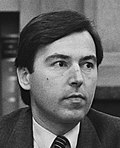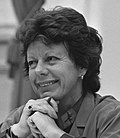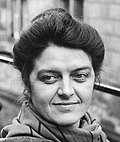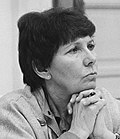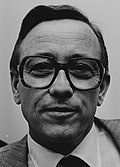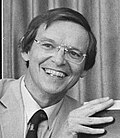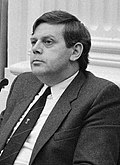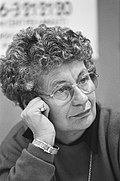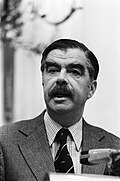The Labour Party is a social-democratic political party in the Netherlands.

The Christian Democratic Appeal is a Christian-democratic political party in the Netherlands. It was originally formed in 1977 from a confederation of the Catholic People's Party, the Anti-Revolutionary Party and the Christian Historical Union; it has participated in all but three cabinets since it became a unitary party.
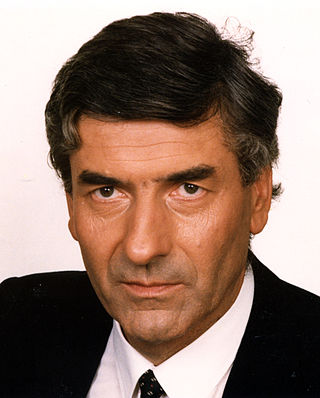
Rudolphus Franciscus Marie "Ruud" Lubbers was a Dutch politician, diplomat and businessman who served as Prime Minister of the Netherlands from 1982 to 1994, and as United Nations High Commissioner for Refugees from 2001 to 2005. He was a member of the Catholic People's Party (KVP), which later merged to become the Christian Democratic Appeal (CDA) party.
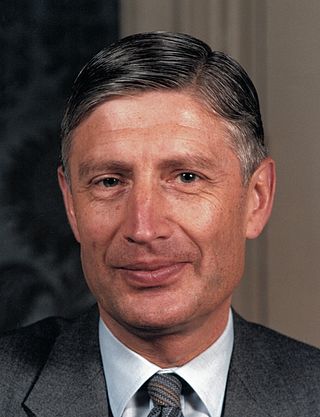
Andreas Antonius Maria "Dries" van Agt is a Dutch politician and diplomat of the defunct Catholic People's Party (KVP) and later the Christian Democratic Appeal (CDA) party and jurist who served as Prime Minister of the Netherlands from 19 December 1977 until 4 November 1982.

Johannes Marten den Uijl, better known as Joop den Uyl was a Dutch politician and economist who served as Prime Minister of the Netherlands from 1973 to 1977. He was a member of the Labour Party (PvdA).

The second Balkenende cabinet was the executive branch of the Government of the Netherlands from 27 May 2003 until 7 July 2006. The cabinet was formed by the Christian-democratic Christian Democratic Appeal (CDA), the conservative-liberal People's Party for Freedom and Democracy (VVD), and the social-liberal Democrats 66 (D66) after the election of 2003. The cabinet was a centre-right coalition and had a slim majority in the House of Representatives with Christian Democratic Leader Jan Peter Balkenende serving as Prime Minister. Liberal Leader Gerrit Zalm, a former Minister of Finance, served as Deputy Prime Minister and returned as Minister of Finance, while former Progressive-Liberal Leader Thom de Graaf served as Deputy Prime Minister and Minister without Portfolio for the Interior.
The Catholic People's Party was a Catholic Christian democratic political party in the Netherlands. The party was founded in 1945 as a continuation of the Roman Catholic State Party, which was a continuation of the General League of Roman Catholic Caucuses. During its entire existence, the party was in government. In 1977, a federation of parties including the Catholic People's Party, the Anti-Revolutionary Party (ARP) and the Christian Historical Union (CHU) ran together under the Christian Democratic Appeal (CDA) banner. The three participating parties formally dissolved to form the CDA in 1980.

The Political Party of Radicals was a Christian-radical, progressive Christian and green political party in the Netherlands. The PPR played a relatively small role in Dutch politics and merged with other left-wing parties to form GreenLeft in 1991.

The first Kok cabinet, also called the first Purple cabinet was the executive branch of the Dutch government from 22 August 1994 until 3 August 1998. The cabinet was formed by the social-democratic Labour Party (PvdA), the conservative-liberal People's Party for Freedom and Democracy (VVD), and the social-liberal Democrats 66 after the election of 1994. The cabinet was a centrist grand coalition and had a substantial majority in the House of Representatives with Labour Leader Wim Kok serving as Prime Minister. Prominent Liberal politician Hans Dijkstal served as Deputy Prime Minister and Minister of the Interior, while Progressive-Liberal Leader Hans van Mierlo served as Deputy Prime Minister and Minister of Foreign Affairs.

The Third Lubbers cabinet, also called the Lubbers–Kok cabinet, was the executive branch of the Dutch government from 7 November 1989 to 22 August 1994. The cabinet was formed the christian-democratic Christian Democratic Appeal (CDA) and the social-democratic Labour Party (PvdA) after the election of 1989. The cabinet was a centrist grand coalition and had a substantial majority in the House of Representatives with Christian-Democratic Leader Ruud Lubbers serving as Prime Minister. Labour Leader Wim Kok served as Deputy Prime Minister and Minister of Finance.

The Second Lubbers cabinet was the executive branch of the Dutch Government from 14 July 1986 until 7 November 1989. The cabinet was a continuation of the previous First Lubbers cabinet and was formed by the Christian-democratic Christian Democratic Appeal (CDA) and the conservative-liberal People's Party for Freedom and Democracy (VVD) after the election of 1986. The cabinet was a centre-right coalition and had a substantial majority in the House of Representatives with Christian-Democratic Leader Ruud Lubbers serving Prime Minister. Former Liberal Leader Rudolf de Korte the Minister of the Interior in the previous cabinet served as Deputy Prime Minister and Minister of Economic Affairs.

The Second Van Agt cabinet was the executive branch of the Dutch Government from 11 September 1981 until 29 May 1982. The cabinet was formed by the christian-democratic Christian Democratic Appeal (CDA), the social-democratic Labour Party (PvdA) and the social-liberal Democrats 66 (D'66) after the election of 1981. The cabinet was a centrist grand coalition and had a substantial majority in the House of Representatives with Christian-Democratic Leader Dries van Agt serving as Prime Minister. Former Labour Prime Minister Joop den Uyl the Labour Leader served as Deputy Prime Minister, Minister of Social Affairs and Employment and was given the portfolio of Netherlands Antilles Affars, Progressive-Liberal Leader Jan Terlouw served as Deputy Prime Minister and Minister of Economic Affairs.

The First Van Agt cabinet, also called the Van Agt–Wiegel cabinet was the executive branch of the Dutch Government from 19 December 1977 until 11 September 1981. The cabinet was formed by the christian-democratic Christian Democratic Appeal (CDA) and the conservative-liberal People's Party for Freedom and Democracy (VVD) after the election of 1977. The cabinet was a centre-right coalition and had a slim majority in the House of Representatives with Christian Democratic Leader Dries van Agt serving as Prime Minister. Liberal Leader Hans Wiegel served as Deputy Prime Minister and Minister of the Interior.

Mark Rutte is a Dutch politician who has served as Prime Minister of the Netherlands since 2010 and Leader of the People's Party for Freedom and Democracy (VVD) since 2006.

The third Balkenende cabinet was the executive branch of the Government of the Netherlands from 7 July 2006 until 22 February 2007. The cabinet was formed by the Christian-democratic Christian Democratic Appeal (CDA) and the conservative-liberal People's Party for Freedom and Democracy (VVD) after the fall of the second Balkenende cabinet. The caretaker rump cabinet was a centre-right coalition and had a minority in the House of Representatives with Christian Democratic Leader Jan Peter Balkenende serving as Prime Minister. Former Liberal Leader Gerrit Zalm continued as Deputy Prime Minister and Minister of Finance.

Following the 2006 Dutch general election, held on November 22, a process of cabinet formation started, involving negotiations about which coalition partners to form a common programme of policy and to divide the posts in cabinet. On February 22, 2007 it resulted in the formation of the Fourth Balkenende cabinet.

The fourth Balkenende cabinet was the executive branch of the Government of the Netherlands from 22 February 2007 until 14 October 2010. The cabinet was formed by the Christian-democratic Christian Democratic Appeal (CDA) and Christian Union (CU) and the social-democratic Labour Party (PvdA) after the election of 2006. The cabinet was a centrist grand coalition and had a slim majority in the House of Representatives with Christian Democratic Leader Jan Peter Balkenende serving as prime minister. Labour Leader Wouter Bos served as Deputy Prime Minister and Minister of Finance while Social Christian Leader André Rouvoet served as Deputy Prime Minister and Minister without Portfolio for Health, Welfare and Sport.

Wilhelm Friedrich "Gaius" de Gaay Fortman was a Dutch jurist and politician of the Anti-Revolutionary Party (ARP), which later merged into the Christian Democratic Appeal (CDA) party.

Following the Dutch general election of 2010, held on 9 June, a process of cabinet formation started, which typically involves three phases:
- exploring with which parties to form a coalition,
- negotiating to draft a coalition agreement,
- dividing the posts in the new cabinet.

The first Rutte cabinet, also called the Rutte–Verhagen cabinet was the executive branch of the Government of the Netherlands from 14 October 2010 until 5 November 2012. The cabinet was formed by the conservative-liberal People's Party for Freedom and Democracy (VVD) and the Christian-democratic Christian Democratic Appeal (CDA) after the election of 2010. The cabinet was a right-wing coalition and had a minority in the House of Representatives but had confidence and supply from the Party for Freedom (PVV) for a slim majority with Liberal Leader Mark Rutte serving as Prime Minister. Christian Democratic Leader Maxime Verhagen served as Deputy Prime Minister and Minister of Economic Affairs, Agriculture and Innovation.



























